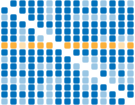Cadiot, Olivier: Why I Became a Saint (Pourquoi je deviens un saint in English)
Pourquoi je deviens un saint (French)J’avais installé sous l’arbre une sorte d’auvent fait de planches sous lequel étaient dressés une table et un lit de corde qui me servaient à venir travailler l’été face au canal de dérivation qui descendait du lac et à surveiller en même temps les lignes de fond tendues à l’endroit où l’eau douce rencontrait l’eau salée et où pullulait une sorte d’anguille blanche dont je capturais les alevins que je faisais grandir. Plus de ciel Et je fermais les yeux Le soir je devais continuer à faire le plan de l’île—préparatoire à la maquette en volume—en utilisant des hachures dont l’espacement est en raison inverse de la rapidité des pentes est égal au quart de la distance entre deux courbes consécutives comme j’avais appris à le faire à. Tout en dessinant je me rendais compte que je devenais de plus en plus contemplatif. C’est par ennui qu’X devient un saint, par pur désoeuvrement, mais ça c’est encore «pourquoi il devient un saint » pas « comment». Et depuis quand? Il est certain que si l’on mesure une côte accidentée il faut savoir s’arrêter sinon on doit tenir compte de l’angle d’un caillou ou de la disposition d’un grain de sable. Le saint Dans ma cellule à écrire—relire—consulter—sur l’estrade en forme de maison surélevée—avec les hautes fenêtres de l’espace contenant—le lion arrêté sur le carrelage—le paon inactif et la perdrix absente—les oiseaux zébrant les fenêtres en haut—pâle jour autour—moi logé dans l’espace en bois ingénieux—comme rangé dans un bureau—écrivant dans un meuble—pensant dans les tiroirs—tout autour noir—le lion au fond gambadant sur le carrelage. La perdrix absente et le paon inactif.
|
Why I Became a Saint (English)Under a tree, I’d constructed a rough shed made of planks in which I’d put a table and a rope bed to use when I came to work in the summer. As it faced the main canal running down to the lake, I could keep an eye on the fishing lines dropped in at the precise point where the fresh water meets the salt water and supports a species of white eel whose young I captured and raised. More sky And I closed my eyes In the evening I had to continue to map the island—precursor to the scale model—using cross-hatchings whose spacing in inverse relation to the slope is equal to a quarter of the distance between two consecutive curves as I’d learned to do at. As I was drawing, I realized that I was becoming more and more contemplative. Through boredom X became a saint through boredom, through sheer laziness, but that’s still ‘‘why he became a saint’’ not ‘‘how.’’ And since when? It’s well known that if you set out to measure a rough coastline you’d better know where to stop or you’ll end up having to consider the angle of every stone and the position of every grain of sand. The saint In my cell to write—reread—consult—on a raised dais its own home—with high windows on the space containing—the lion on the flagstones poised—the peacock on hold and the partridge dazed—birds striating the windows above—pale day around—me living a space of intricate sculpted wood—writing-studio-ascoat—to write inside a desk—thinking in the drawers—a cool dark all around—with lion in the background ballet upon the flagstones. The partridge dazed and the peacock on hold.
|




